
The Ferrari 166 S was a sports racing car built by Ferrari between 1948 and 1953, an evolution of its Colombo V12-powered 125 S racer. It was adapted into a sports car for the street in the form of the 166 Inter.
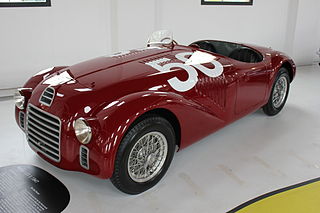
The Ferrari 125 S was a 1.5 litre race car built in 1947 by automaker Ferrari of Modena, Italy, its first vehicle. Only two were made.

The Auto Avio Costruzioni 815 was the first car to be fully designed and built by Enzo Ferrari. Legal issues with former associates Alfa Romeo prevented Ferrari from creating the Ferrari marque. The 815 raced at the 1940 Brescia Grand Prix, where both entries failed to finish due to engine problems. One of the cars was later scrapped, while the other is currently in a car collection in Italy.

The Ferrari 340 Mexico was a Ferrari sports racing car which was intended for the 1952 Carrera Panamericana. It used 4.1 L Lampredi V12 engine producing around 280 PS (206 kW) at 6600 rpm, for a maximum speed of 280 km/h. Just 4 were made in 1952, 3 Vignale Berlinettas and 1 Vignale Spyder; all designed by Giovanni Michelotti. Mexico used a 2,600 mm (102.4 in) wheelbase. Chinetti and Lucas finished the race at third place in berlinetta.

The 125 F1 was Ferrari's first Formula One car. It shared its engine with the 125 S sports racer which preceded it by a year, but was developed at the same time by Enzo Ferrari, Valerio Colotti and designer, Gioacchino Colombo. Initially the racer was called 125 GPC for Gran Premio Città or Grand Prix Compressore before the Formula One era.

The Ferrari 195 S was a sports racing car produced by Ferrari in 1950. It was an improved version of the 166 MM. The 195 S won Mille Miglia, Coppa della Toscana and Giro delle Calabria.

The Ferrari 250 S was a sports racing car produced by Ferrari in 1952. It was the first in the long lineage of Ferrari 250 road and race cars powered by a ubiquitous 3.0-litre Colombo V12 engine. In 1952 the 250 S won the Mille Miglia and 12 Hours of Pescara. At the Le Mans, the same year, it clocked the fastest race lap time. Only a single example was produced.

The Ferrari 225 S was a sports racing car produced by Ferrari in 1952. It was an evolution over the preceding Ferrari 212 Export with important engine upgrades that greatly improved power output. The model was extensively used in competition, winning many international races. The most important include 1952 Monaco Grand Prix for sports cars, Portuguese Grand Prix, Coppa d'Oro di Sicilia, Coppa della Toscana, Coppa d'Oro delle Dolomiti and many others. It was the final Colombo V12 engine iteration before the 250-family stretched it to 3.0-litres capacity.

The Ferrari 212 Export was a sports racing car produced by Ferrari in 1951–1952. The 212 Exports won Tour de France automobile, Giro di Sicilia, Coppa della Toscana, 10 Hours of Messina and other motor races throughout its career. It was meant to be a sports car available for oversea markets.

The Ferrari 375 Plus was a sports racing car produced by Ferrari in 1954. The model competed internationally, winning many major races, including 24 Hours of Le Mans, Carrera Panamericana, 1000km of Buenos Aires, Agadir GP and Silverstone.
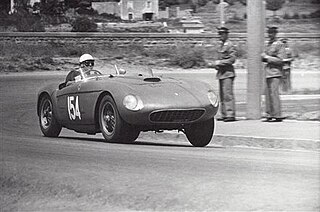
The Ferrari 250 Monza was a sports racing car produced by Ferrari in 1954. It was a combination of a stretched chassis and body from the line of inline-four-engined racers with an ubiquitous 3.0-litre Colombo V12 engine.

The Ferrari 315 S was a sports racing car produced by Ferrari in 1957. The model was intended to succeed the Ferrari 290 MM, which had won the 1956 Mille Miglia.
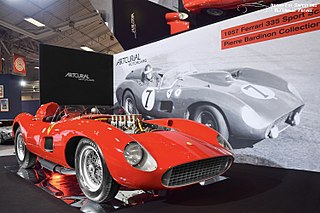
The Ferrari 335 S was a sports racing car produced by Italian manufacturer Ferrari in 1957. The car was a direct response to the Maserati 450S which with its 4.5-litre engine was threatening to overpower the 3.8-litre 315 S and 3.5-litre 290 MM. Four cars were produced in total.
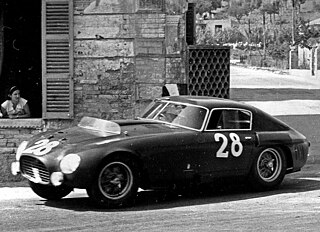
The Ferrari 375 MM, was a sports racing car produced by Ferrari in 1953 up to 1955 for the road cars. It was named "375" for the unitary displacement of one cylinder in the 4.5 L V12 engine, and the "MM" stood for the Mille Miglia race. In total 26 units were made, including four converted from the 340 MM.

The Ferrari 275 S was a sports racing car produced by Ferrari in 1950. It was the first Ferrari powered by a new Aurelio Lampredi-designed V12 engine, created as a large displacement alternative to the initial 1,5 L Colombo V12, used in supercharged form in Ferrari 125 F1. Formula One regulations allowed for up to 4.5 L in naturally aspirated form.

The Ferrari 250 MM was a sports racing car produced by Ferrari in 1953. After the initial racing successes of the 3.0-litre Colombo V12 engine, introduced in the 250 S one-off, Ferrari produced a serial racing model. It is best recognisable for the distinctive closed berlinetta bodywork by Pinin Farina. The "MM" in its name stood for the Mille Miglia race.

The Ferrari 735 LM was a sports racing car produced by Ferrari in 1955. It was the second raced Ferrari, powered by an Aurelio Lampredi-designed inline-6 engine, created as a larger displacement evolution to the engines used in the Ferrari Monza race cars.

The Ferrari 290 S was a sports racing car produced by Ferrari in 1957. It was a development of an earlier 290 MM race car that won the 1956 Mille Miglia. The 290 S was the first sports car manufactured by Ferrari to be powered by a DOHC V12 engine. Its career was very short but it served as an important milestone in the Jano V12-powered lineage.

The Dino 206 S is a sports prototype produced by Ferrari in 1966–1967 under the Dino marque. Ferrari intended to produce at least fifty examples for homologation by the CSI in the Sport 2.0 L Group 4 category. As only 18 were made, the car had to compete in the Prototype 2.0-litre class instead. In spite of this handicap the Dino 206 S took many class wins. The 206 S was the last of the Dino sports racing cars and simultaneously the most produced.
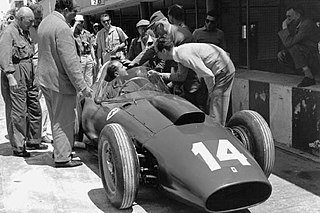
The Ferrari 326 MI was a single-seater manufactured by Ferrari in 1958. It was a one-off race car purpose-built for the second edition of the 500 Miles of Monza. It was one of the two special cars created to compete with American race cars on an Italian race track. Following the naming convention, "326" stood for 3.2-litre, 6-cylinder engine. The "MI" suffix stood for "Monza-Indianapolis".





















